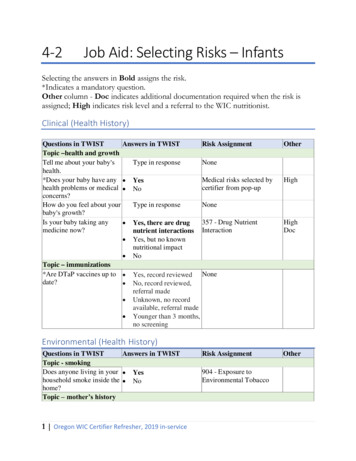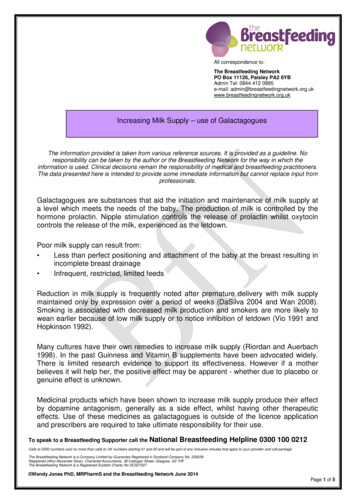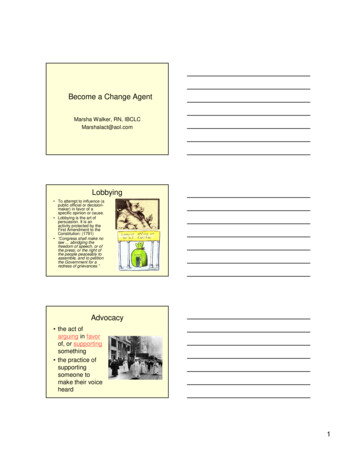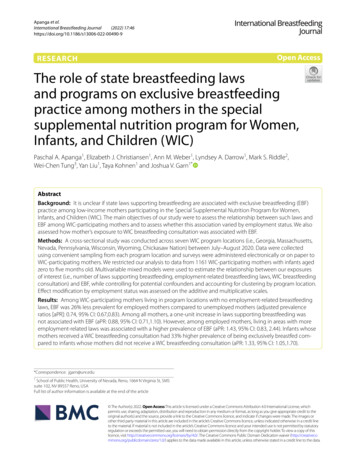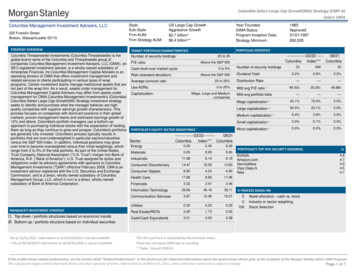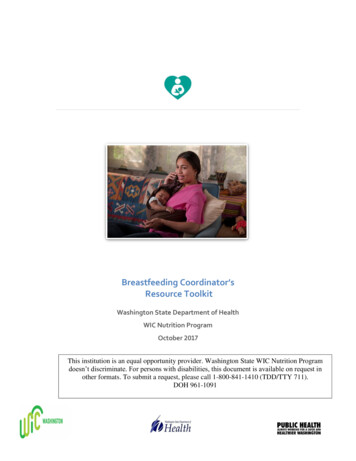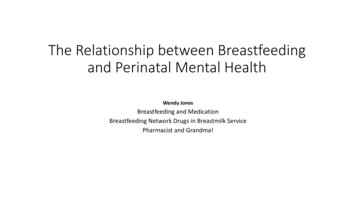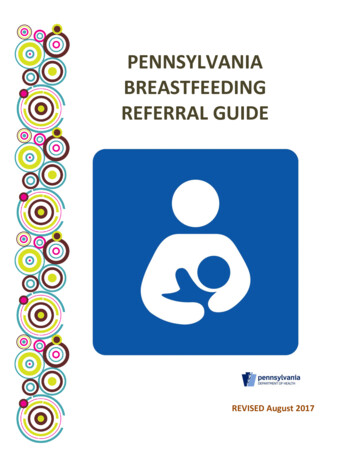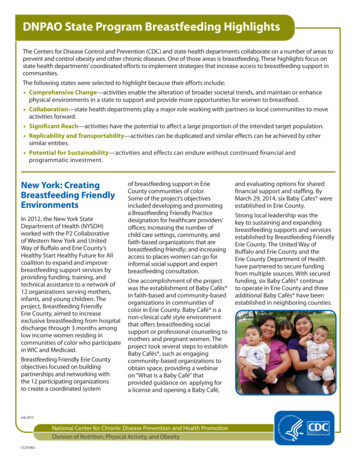
Transcription
District of ColumbiaWorkplaceBreastfeeding SupportToolkitSeptember 2021DC HEALTHGOVENMENT OF THE DISTRICT OF COLUMBIA
ACKNOWLEDGEMENTSGovernment of the District of ColumbiaMuriel Bowser, MayorDC Department of HealthLaQuandra S. Nesbitt, MD, MPH, DirectorThomas Farley, MD, MPH, Senior Deputy DirectorCommunity Health AdministrationRobin (Diggs) Perdue, MPH,Deputy Director of Strategy, Programs, and Policy,Community Health AdministrationSara Beckwith, MS, RDN, LD, Bureau Chief,Community Health AdministrationAkua Odi Boateng, MS, RDN, LD, WIC State DirectorNoni Robinson, MS, Project Manager, WIC ProgramContributing MembersMudiwah A. Kadeshe, RN, MSN, LNC, IBCLCDC Breastfeeding CoalitionSahira Long, MD, IBCLC, FAAP, FABMWDC Breastfeeding CoalitionPrepared byGladys M. Desselle, RN, BSN, MHA, IBCLC, NEA-BCDC Breastfeeding CoalitionContent EditorGregory Long, Innerstages LLCGraphic Designer
ContentsIntroduction 4The Benefits 6The Laws 9District of Columbia Employers 10The Basics 11Beyond Basics 11Sample Workplace Breastfeeding Support Policy 1 12Sample Workplace Breastfeeding Support Policy 2 14Breastfeeding Program Essentials 16Breastfeeding Program Checklist 17District of Columbia Employees 18Letter from Primary Care Provider 21References 22Resources for Employers and Employees 23District of Columbia Workplace Breastfeeding Support Toolkit September 20213
District of ColumbiaWORKPLACE BREASTFEEDINGSUPPORT TOOLKITIntroductionBreastfeeding offers important and lifelong health benefits. At delivery, eighty-eight percentof women in the District of Columbia initiate and intend to breastfeed their child for therecommended duration of six months. Unfortunately, for them, and for our community, mostdo not meet their desired breastfeeding goals.According to the American Academy of Pediatrics, breastfeeding offers health benefits to bothinfants and mothers. Infants who are breastfed have reduced risks of a number of diseasesincluding sudden infant death syndrome (SIDS), ear and respiratory infections, and gastrointestinal illness. Mothers who breastfeed have a reduced risk for various diseases includinghypertension, diabetes, and breast cancer. These health benefits can translate into economicbenefits such as lower medical costs or fewer sick days away from work.The American Academy of Pediatrics and other U.S. health organizations recommend exclusivebreastfeeding for about 6 months, followed by continued breastfeeding until at least 12months of age as complementary foods are introduced.However, breastfeeding rates in the United States, and the District of Columbia — in particular, forduration and exclusive breastfeeding (EBF) — fall short of recommended levels at six months of age.Data from the U.S. Centers for Disease Control and Prevention (CDC) National ImmunizationSurvey (NIS) indicate that 83.9% of U.S. infants born in 2018 started to breastfeed, however,only 25.8% percent were exclusively breastfed at 6 months.According to the most recent data available from the CDC NIS, women in the District,Maryland, and Virginia initiate breastfeeding at similar rates, DC 85.4%, MD 86.8%, and VA87.5%. Moreover, according to the CDC report, the District’s 6 month exclusivity rate of 26.3%is slightly lower than its neighboring communities, MD 26.6% and VA 27.5%. See the full surveyresults here: cdc.gov/breastfeeding/data/nis data/rates-any-exclusive-bf-by-state-2018.htmThere are many reasons why nursing mothers are unable to breastfeed for as longas they initially desire. For example, many "give up"early when they experience pain4District of Columbia Workplace Breastfeeding Support Toolkit September 2021
Breastfeeding Rates among Infants Born in 20181,2DCMDVAUS National0102030405060708090100Percentage of Infants Initiating Breastfeeding at BirthPercentage of Exclusively Breastfed Infants at 6 months1 Data from the U.S. territories are excluded from the national breastfeeding estimates to be consistentwith the analytical methods for the establishment of Healthy People 2030 targets on breastfeeding.2 Exclusive breastfeeding is defined as ONLY breast milk — NO solids, no water, and no other liquids.Source: National Immunization Survey, Centers for Disease Control andPrevention, Department of Health and Human Servicesrelated to improper latch, concerns about producing enough milk, and cultural mythsabout breastfeeding. Many are unaware of evidence-based online resources, and thepotential eligibility for personal support from a lactation professional through the SpecialSupplemental Nutrition Program for Women, Infants, and Children (WIC), Medicaid, orprivate health insurance plans.It is known that when working mothers receive workplace support, they are more likelyto continue to successfully breastfeed their child, achieve their duration goals, experiencebetter health, and have increased job satisfaction. There are local and federal laws in place toallow employees, businesses and our community to reap the many benefits of infants gettingbreast milk for the first year or more of life. Therefore, the District of Columbia has createdthis Toolkit to support employers and empower employees to maintain breastfeeding in theworkplace for as long as mothers desire.District of Columbia Workplace Breastfeeding Support Toolkit September 20215
The BenefitsBusinesses that implement suppor vebreas eeding policies and prac cesnot only benefit the working motherbut also provide a number of benefitsto the baby and the employer6
Benefits for BabyBreastfed children experience improved dental health and neurodevelopmentaloutcomes. They also have a decreased risk of:Allergies, Asthma, Colds, Celiac Disease, Childhood overweight and obesity, Crohn’sDisease, Diarrhea, Ear infections, Eczema, Late onset sepsis in preterm infants,Leukemia, Necrotizing enterocolitis, Respiratory tract infection, SID’s-Sudden InfantDeath Syndrome, and Type 1 and Type 2 Diabetes.Benefits for Mother (Employee)Improved health: Breastfeeding can lower rates of:Type 2 Diabetes; Hypertension; Breast , Ovarian, Endometrial and Thyroid Cancer;and Rheumatoid Arthritis.Lower absenteeism: Mothers who have the option to breastfeed in the workplace havehealthier children and fewer unplanned absences.Improved focus: Mothers who are able to express breast milk in the workplace arebetter able to concentrate during the workday. If a mother is unable to express milk,she may acquire an infection or a decrease in supply, which may lead to emotional andphysical distress.Higher Productivity: Mothers who are supported in their desire to continue to breastfeedwhile returning to employment often demonstrate higher levels of productivity.Benefits for EmployerHigher Productivity: Employees who have breastfeeding support tend to havefewer unscheduled absences and less tardiness because their infants are moreresistant to sickness.Increased Loyalty: The implementation of an effective support program demonstratesthat the organization supports their employees health and family.Improved Recruitment & Retention: Breastfeeding support programs serve as arecruitment tool. Businesses that offer effective programs often have higher retentionrates for female employees.Greater Job Satisfaction: Businesses that display support for their employees facilitategreater workplace satisfaction.District of Columbia Workplace Breastfeeding Support Toolkit September 20217
Community Breastfeeding SupportThis guide seeks to educate and equip the community with information and tools thatwill provide employees, employers, coworkers, friends, and family with knowledge of theadvantages of breastfeeding.1. Research indicates breastfeeding is a way to improve the health ofour families and communities. However, many are not aware of theproven benefits, and the law’s, which are in place to support motherswho provide milk to their children once they return to work.2. You will find information in this toolkit on The Laws, The Benefits, and The Supportrequired to better understand your role in assisting, not only the women in yourworkplace, but those in your family and community as well. Please help to protect,support and promote breastfeeding at work and in the District’s communities!The American Academy of Pediatrics, Policy Statement on Breastfeeding, and the World HealthOrganization’s, The Investment Case for Breastfeeding, both highlight how the U.S. could savemore than 13 billion in health care costs and save the lives of nearly 1,000 babies if 90% ofwomen nurse their infants exclusively to at least the recommended 6 months of age.8District of Columbia Workplace Breastfeeding Support Toolkit September 2021
THE LAWSFederalThe 2010 Patient Protection andAffordable Care ve March 23, 2010, the PatientProtection and Affordable Care Actamended the Fair Labor Standards Act(FLSA) and requires most employersto offer a breastfeeding employeereasonable break times to pump for up to1 year after her baby is born and a placeother than a bathroom to comfortably,safely, and privately express breast.District of ColumbiaThe District of Columbia HumanRights Act of 1977, as 2-1402.82.htmlAllows women to breastfeed their childanywhere in DC that they have theright to be. It also mandates employeraccommodations for breastfeeding.The law states:An employer shall provide reasonabledaily unpaid break-time, as requiredby an employee so she may expressbreast milk for her child.An employer shall make reasonableefforts to provide a sanitary roomor other location in close proximityto the work area, other than abathroom or toilet stall, where anemployee can express her breastmilk in privacy and security.An employer must create a policy forbreastfeeding mothers and must postand maintain a poster in a conspicuousplace that sets forth these requirements.District of Columbia Workplace Breastfeeding Support Toolkit September 20219
District of Columbia EmployersCongratulations! We applaud your efforts to Promote, Support and Protect members of yourorganization in achieving their breastfeeding goals! This guide seeks to provide employers:1. Information to share with all members of the organization on the legal responsibilities,(The Laws) and health and business benefits (The Benefits) of breastfeeding.2. Sample policies and posters, based on information from the Health and HumanServices (HHS) website and the DC Office of Human Rights (OHR) that can be used toassure understanding and compliance by all employees, managers and supervisors.3. Recommendations, in addition to the required policies, for implementation ofa Lactation Support Program; when met the organization may be recognized bythe DC Breastfeeding Coalition as a Breastfeeding Friendly Employer. Informationon how to establish and champion a breastfeeding program is also provided.The Protecting Pregnant Workers Fairness Act of 2014 (PPWFA)ohr.dc.gov/page/pregnantworkersRequires District of Columbia employers to provide reasonable workplace accommodationsfor employees whose ability to perform job duties is limited because of pregnancy, childbirth,breastfeeding, or a related medical condition.Any employee working in the District of Columbia who believes their rights have been violatedunder the act has up to one year to file a complaint, or 180 days if employed by the Districtof Columbia. If you believe you have been discriminated against under the Act, contact theDistrict of Columbia Office of Human Rights at (202) 272-4559 or ohr.dc.gov.10District of Columbia Workplace Breastfeeding Support Toolkit September 2021
The BasicsBeyond BasicsAccording to the District of Columbia Officeon Human Rights (OHR), employers in theDistrict of Columbia are required to have anorganizational policy which supports andexplains to all individuals employed, not justthose requiring lactation support, the rightsof the mother and all new parents, and theorganization’s legal responsibilities. To aidyou the OHR has created posters explainingthese rights, which are to be conspicuouslydisplayed. Click the link below to obtaincopies of the three OHR Workplace Postersoutlining each of the following laws:Employers who not only have themandated policy but take the next step ofchampioning and implementing a LactationSupport Program, report an average 3:1return on investment, according to theBusiness Case for Breastfeeding!Parental Leave ActThe Right to BreastfeedDistrict Of Columbia Family &Medical Leave Act r/publication/attachments/DCFMLAFactSheet.pdfThe sample policies, forms and handoutsprovided in the toolkit are based onrecommendations from local District ofColumbia agencies and federal governmentagencies including the Department of Labor,Centers for Disease Control and Preventionand HHS Women’s Office on Health. Theyare not copyrighted and may be reproducedwithout permission.The policies may be modified to better fityour unique specifications. Keep in mindit must address the employees right tohave time to express her milk, a privatenon bathroom space that is secure, andthe mutual responsibilities of both, theemployer as well as the employee.Potential employees will see evidencethat yours is a company that supportswomen and families. Not sure how toput it all together? We have includedrecommendations to get you started.Recruit some members of your team fromdiverse jobs if possible and let them createthe support system they would love tohave! Most likely they will want to remainwith your wonderful supportive companyonce they do, increasing your employeeretention rates!“Establish policies tosupport women’s abilitiesto breastfeed, to reachtheir breastfeeding goalsonce they return to theircommunities and worksites,and thus achieve full healthbenefits of breastfeeding fortheir babies and themselves.”— Surgeon General’s 2011 call for Actionto Support Breastfeeding StatementDistrict of Columbia Workplace Breastfeeding Support Toolkit September 202111
Sample WorkplaceBreastfeeding Support Policy 1Breastfeeding has been shown to be the superior formof infant nutrition, providing a multitude of healthbenefits to both infants and mother, and becausebreastfeeding employees need ongoing supportin the worksite to be able to provide their milk fortheir babies, [Organization Name] subscribes to thefollowing policy:1. Employees shall be provided a place tobreastfeed or express their milk. An employeelactation room is provided as a private andsanitary place for breastfeeding employees toexpress their milk during work hours. This roomprovides an electrical outlet, comfortable chair,and nearby access to running water. Employeesmay, of course, use their private office area forbreastfeeding or milk expression, if they prefer.2. A refrigerator will be made available for safestorage of expressed breast milk. Employees mayuse their own cooler packs to store expressedbreast milk or may store milk in a designatedrefrigerator/freezer. Employees should providetheir own containers, clearly labeled with nameand date. Those using the refrigerator areresponsible for keeping it clean.3. Employees shall be provided flexible breaks toaccommodate breastfeeding or milk expression.A breastfeeding employee shall be provided aflexible schedule for breastfeeding or pumping toprovide breastmilk for her child. The time shouldnot exceed normal time allowed for lunch andbreaks. For time above and beyond normal lunchand breaks, sick or annual leave time can be used,or the employees can come in a little early orleave a little later to make up the time. (It is notrecommended to dock time or decrease wages.)12District of Columbia Workplace Breastfeeding Support Toolkit September 2021
4. Staff are expected to provide support for breastfeeding employees. Realizing theimportance of breastfeeding to the infant, the mother, and the company, all staff areexpected to provide an atmosphere of encouraging support for breastfeeding employees.5. Breastfeeding promotion information will be displayed. The company will provideinformation on breastfeeding to all pregnant and breastfeeding employees, includinglocal resources. In addition, positive promotion of breastfeeding will be on display in thecompany and in-house communications with staff.6. Employee orientation will include information about the company’s breastfeedingpolicy. The company’s breastfeeding policy will be communicated to all current staff.New employees will be informed about the company policy in the new employeeorientation training.District of Columbia Workplace Breastfeeding Support Toolkit September 202113
Sample WorkplaceBreastfeeding Support Policy 2In recognition of the well documented health advantages of breastfeeding for infants andmothers, [Company Name] provides a supportive environment to enable breastfeedingemployees to express their milk during work hours. This includes a company-wide lactationsupport program administered by [Department Name]. [Company Name] subscribes to thefollowing worksite support policy. This policy will be communicated to all current employeesand included in new employee orientation training.Company ResponsibilitiesBreastfeeding employees who choose to continue providing their milk for their infants afterreturning to work shall receive:Use of Break Times to Express MilkBreastfeeding employees are allowed to breastfeed or express milk during work hoursusing their normal breaks and mealtimes. For time that may be needed beyond the usualbreak times, employees may use personal leave or may make up the time as negotiatedwith their supervisors.When more than one breastfeeding employee needs to use the designated lactation room,employees can use the sign-in log provided in the room to negotiate milk expression times thatare most convenient or best meet their needs.A Place to Express MilkA private room (not a toilet stall or restroom) must be available for employees to breastfeedor express milk. The room will be private and sanitary, located near a sink with runningwater for washing hands and rinsing out breast pump parts, and have an electrical outlet. Ifemployees prefer, they may also breastfeed or express milk in their own private offices, or inother comfortable locations agreed upon in consultation with the employee’s supervisor. Staffsupport supervisors are responsible for alerting pregnant and breastfeeding employees aboutthe company’s worksite lactation support program, and for negotiating policies and practicesthat will help facilitate each employee’s infant feeding goals. It is expected that all employeeswill assist in providing a positive atmosphere of support for breastfeeding employees. [Listother components specific to your company’s program]Breastfeeding Equipment[Company Name] [provides/subsidizes/rents] electric breast pumps to assist breastfeedingemployees with milk expression during work hours. The company [provides/subsidizes/rents]hospital grade pumps that can be used by more than one employee or [provides/subsidizes]portable personal use electric breast pumps that the employee retains throughout the courseof breastfeeding. If the employee is using a standard hospital-grade pump, indicate whether the14District of Columbia Workplace Breastfeeding Support Toolkit September 2021
company provides/subsidizes personal attachment kits or where the employee can purchase thekit. Indicate whether breast pumps are also available for partners of male employees.EducationPrenatal and postpartum breastfeeding classes and informational materials are available forall mothers and fathers, as well as their partners. Staff support supervisors are responsiblefor alerting pregnant and breastfeeding employees about the company’s worksite lactationsupport program, and for negotiating policies and practices that will help facilitate eachemployee’s infant feeding goals. It is expected that all employees will assist in providing apositive atmosphere of support for breastfeeding employees. [List other components specificto your company’s program]Employee ResponsibilitiesBreastfeeding employees who choose to continue providing their milk for their infants afterreturning to work shall commit to the following:Communication with SupervisorsEmployees who wish to express milk during the work period will keep supervisors informed oftheir needs so that appropriate accommodations can be made to satisfy the needs of both theemployee and the company.Maintenance of Milk Expression AreasBreastfeeding employees are responsible for keeping milk expression areas clean, usingantimicrobial wipes to clean the pump and area around it. Employees are also responsible forkeeping the general lactation room clean for the next user.This responsibility extends to both designated milk expression areas, as well as other areaswhere expressing milk will occur. Employees storing breast milk should label all milk expressedwith their name and date collected so it is not inadvertently confused with another employee’smilk. Expressed milk can be stored in a company refrigerator, a designated refrigeratorprovided in the lactation room, or a personal storage cooler.District of Columbia Workplace Breastfeeding Support Toolkit September 202115
Breastfeeding Program Essentials(For use by Human Resources, Company Owners,and Designated Lactation Workplace Champions) Create a clean, permanent room withnatural or soft lighting, calming décor,and a comfortable temperature. Offer a secure room that locks fromthe inside and still allows entry fromEmergency Response Personnel. Furnish comfortable seatingsuch as ergonomic chairs. Provide access to a sink with hot andcold running water and a microwave[optional] for the sterilizationof materials and supplies. Equip the room with a hospital gradebreast pump and a refrigerator with afreezer section and ice packs exclusivelyfor the storage of breast milk. Access to electricity and a clock. Provide a mirror for mothersto check/adjust their clothingprior to leaving the room. Establish a bulletin board for postinginformation on events and classesfor parents, pumping schedules, andphotos of the mother’s babies whichcan encourage breast milk flow. Provide contact information for locallactation consultants: dcbfc.org Provide access to pregnancy andbreastfeeding information fornursing mothers that assist themin addressing common issues:womenshealth.gov/breastfeeding Provide a point of contact whois readily available for questionsregarding the nursing mother’sprogram, checklist provided. Educate co-workers on the necessity andbenefits of supporting the expressionof breast milk in the workplace. Provide ways for employees to givefeedback to the business regardingthe nursing mother’s experience. Administer a daily cleaningregimen for the private space,provided by the business. Prepare a sign-up sheet, either onlineor posted, for use in the nursingmother’s room when you havemultiple employees using space.16District of Columbia Workplace Breastfeeding Support Toolkit September 2021
Breastfeeding Program ChecklistFor use by Human Resources, Company Owners, Supervisors or Designated Lactation Workplace Champions.When an employee requests lactation accommodations, the following checklist can help youplan support and maintain compliance.Praise her! Tell her you will support her decision to breastfeed. Provide a copy and discuss your company’s lactation policy for supporting nursingwomen prior to the employee’s maternity leave, with her and her supervisor so you canmake any arrangements needed while she is away. Assure the employee that her direct supervisor and other relevant managers are awareof her needs and have reviewed and will support the organization’s lactation policy. Review the employee’s typical work/break schedule to arrange for milk expression breaks. If needed, plan to arrange for coverage (such as using "floaters") while she is away fromher workstation.Identify a private space that is not a bathroom that is functional for expressing milk.(See "Supporting Moms at Work" at The Office on Women’s Health, for non-office workenvironment suggestions: ationbreak-time-and-space-all-industries) Seek feedback from the employee and her supervisor. When developing the plan. Checkin to assure all is well, once it is being implemented.District of Columbia Workplace Breastfeeding Support Toolkit September 202117
District of Columbia EmployeesThis guide seeks to provide employees1. Resources to assist with overcoming challenges faced in establishing andmaintaining successful breastfeeding prior to returning to work.2. Resources, recommendations, and specific guidelines to help maintain feedinginfant breast milk, during the transition from maternity leave to the workplace.3. Information on the legal rights parents have in the District of Columbia which support thedesire to continue to express breastmilk upon return to work for at least one year or longer.Congratulations!On your pregnancy, the birth of your child and your decision to breastfeed!“ When you breastfeed, you give your baby a healthy start that lasts a lifetime.Breastmilk is the perfect food for your baby. Breastfeeding saves lives, money, and time.”—Office on Women’s Health in the U.S. Department of Health and Human ServicesWherever you are along the parenthood path, the District of Columbia wants to provideinformation and resources for you. We are committed to protecting and promoting breastmilk as the natural first food, for all who desire to provide human milk to their newborn foras long as they wish.We have covered the laws which protect your right to breastfeed anywhere you have a rightto be. Your employer is required to allow you to take breaks when you return to work toexpress milk throughout the day as needed. See the section titled "The Laws" if you feel yourrights are being denied you have up to one year to file a complaint, or 180 days if you are aDistrict of Columbia employee.Our goal here is to provide you with non-social media resources for answers to questionsyou may have about breastfeeding. Below is Information regarding benefits and programsavailable in the District of Columbia for pregnant and breastfeeding women, and how to findand access professionally trained lactation help you may be entitled to through Medicaid,WIC or or your insurance plan.When you are still pregnant and workingLearn all you can about breastfeeding. Take a class if you can. Many hospitals, clinicsand organizations offer remote internet options. Great online resources are available free ofcharge. Check out the attached video, featuring Dr. Sahira Long, Children’s National Hospital, inDC as she discusses the Secrets of Breastfeeding here: youtu.be/zeBdiBImTAk and The Benefitsof Breastfeeding that only your breast milk can give your baby here: youtu.be/DpVp07lgDsI.18District of Columbia Workplace Breastfeeding Support Toolkit September 2021
Discuss your plan with your employer. Review the company lactation support policy.If there isn’t one, there may not have been a need for one before. Share this toolkit with youremployer. When you do, you will be helping others in the future. Start by discussing time andspace issues for when you return, before you leave. Also explore other possible options whenyou return, such as part time hours or working from home. View the attached video on startingthe conversation with your employer. youtu.be/4t0fk6YoThIInvestigate childcare providers. Will they feed the baby your expressed breast milk?Are they close to your workplace? Can you feed your baby there during lunch breaks or priorto leaving for home when you come to pick your child up?Consider a prenatal consult with a lactation consultant. The cost may becovered in your insurance plan. The personalized assessment and advice on how to get offto a good start may help you set realistic expectations and avoid frustration. Include yourpartner and others involved in infant care at the appointment if possible. Watch this videoBreastfeeding 411, to hear what others found helpful: youtu.be/qHVNTBLZnYoWhen you deliverDuring the first weeks keep your baby close and breastfeed often. Thistime is extremely important in establishing your milk supply. It is important to feed aboutevery 2 to 3 hours around the clock during this time frame. Avoid giving breast milksubstitutes. This commitment could influence how much milk you will have when you returnto work. youtu.be/FlP4wibDzGAKnow your milk is enough. The first milk, colostrum, is rich in antibodies and nutrients.It is all your newborn needs. The more often you nurse, the more milk your body will produce.Don’t become overly concerned that there may not be much at first. The amount of milk youproduce matches the size of your baby’s stomach. In most cases, with
LaQuandra S. Nesbitt, MD, MPH, Director. Thomas Farley, MD, MPH, Senior Deputy Director. Community Health Administration. . and Virginia initiate breastfeeding at similar rates, DC 85.4%, MD 86.8%, and VA . . Below is Information regarding benefits and programs . available in the District of Columbia for pregnant and breastfeeding women .
